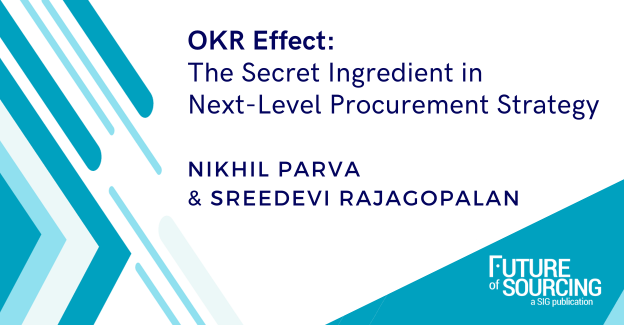In the grand theater of the corporate world, imagine an orchestra in progress, with the musicians responding to the movement of the conductor's baton with grace and precision to create a perfect symphony. Much like a masterful orchestra, each musician has a defined role with distinct beginning and an end. A 'Trust contract' enables the musicians and the conductor to move from one section to another, creating value for their listeners.
Procurement is no different. Like the conductor at an orchestra, procurement professionals work across multiple stakeholders including business, legal & vendors, to create value for their organization. The analogy seems perfect, but stakeholder alignment and having a seat at the table remains elusive and an aspiration for many procurement functions. With each stakeholder group having competing priorities and lacking a 'Trust contract' at times, means lesser value generation. Leading procurement functions, facilitate 30-50% of their company's spend and outperform their peers by up to 10 times in driving increased value. This remarkable improvement is driven by their strategic approach; all procurement leaders consider themselves strategic enterprise business partners, focusing more than 70% of their teams on strategic activities, in contrast to only 17% by other companies. These factors underscore the significant impact of strategic procurement practices on overall performance1.
Let's go back to where it all starts. The procurement planning cycle is a systematic process by which the indirect procurement functions determine their short-, mid-, and long-range goals and plans to achieve them. Typically conducted annually, this process involves evaluating the organization's current state, setting future objectives, including the value generation targets through cost saving, cost avoidance, and devising strategies and tactics to meet those objectives. With inputs from the corporate planning cycle, procurement functions can ensure alignment between overarching corporate objectives and the actions of specific departments or teams. By following the planning cycle, procurement functions aim to improve their overall readiness posture, and adaptability in an ever-changing business environment. Similar to rehearsals in an orchestra, the planning cycle helps the procurement teams plan and practice what they will implement and how best to achieve those outcomes.
While integration with the corporate planning cycle is often assured, integration with business planning cycle is often lacking. Concentrating on the indirect aspects of procurement to adopt an industry-agnostic standpoint, business planning cycles and the related communication often unfold sequentially. Business units typically conclude their roadmaps and allocate OPEX funds in relative isolation during this process. Bottom line impact expectations to indirect procurement teams are often communicated towards the end of the business planning cycle, and that too in a fragmented manner instead of whole, leading to delayed procurement start, loss of valuable time, and a drop in value generation. To make matters worse, suppliers are involved at the far end of the process or not at all, creating a firewall between procurement and implementation teams, who are often interspersed with the vendor teams. Strategic alignment in leading companies, driven by advanced supplier development and innovation, consistently yields a 2X growth and performance advantage, fueled by collaborative joint business planning2. What solution(s) can be implemented to improve integration between business planning cycles and engaging indirect procurement teams?
NEW STATE & OKRs
 What if we were to drive an indirect procurement planning process whereby, we seek active inputs from the business teams while keeping the strategic suppliers informed of aspirational objectives that need their input? Furthermore, what if we were to drive joint ownership of strategic goals that must be delivered with alignment between business teams, procurement, and suppliers with adequate corporate guidance? Would this approach empower the procurement teams to foster deeper trust and deliver enhanced value, akin to the harmonious collaboration seen in a symphony orchestra?
What if we were to drive an indirect procurement planning process whereby, we seek active inputs from the business teams while keeping the strategic suppliers informed of aspirational objectives that need their input? Furthermore, what if we were to drive joint ownership of strategic goals that must be delivered with alignment between business teams, procurement, and suppliers with adequate corporate guidance? Would this approach empower the procurement teams to foster deeper trust and deliver enhanced value, akin to the harmonious collaboration seen in a symphony orchestra?Objectives and Key Results (OKRs) is a structured goal-setting methodology that can help organizations set measurable goals. The methodology has started gaining increased traction in recent times supported by adoption across leading organizations including Amazon, Intel & Microsoft 3. OKR enables organizations to set goals at various levels - company-wide, business unit, and individual. This cascading structure ensures alignment between individual efforts and the larger outcomes of the company or business. Here’s an example of procurement level objectives and key results4.
Objective: Identify and implement cost-saving initiatives in procurement
Key Results:
1. Achieve 10% reduction in overall procurement costs.
2. Increase cost savings through negotiations or strategic sourcing by 20%.
3. Implement 3 process improvements or efficiency measures to reduce purchasing expenses for the organization.
The beauty of OKRs lies in their simplicity and effectiveness. By setting clear objectives that are ambitious yet attainable, organizations can drive focus and prioritize their efforts towards achieving desired results. The key results act as measurable milestones that indicate progress towards the objectives. One of the key benefits of OKRs is their ability to provide clarity and transparency throughout the organization. When every team member understands how their individual contributions tie into the broader company or business-wide goals, it creates a sense of purpose and accountability in-line with the organization’s overall corporate mission, vision, and goals.
For individual contributors, OKRs offer a framework to evaluate their own performance within the context of organizational objectives. They can assess how their efforts directly contribute to the success of the company or business unit. This not only helps in aligning personal aspirations with organizational goals but also provides a roadmap for growth and development. OKRs serve as a powerful tool for goal setting and performance management at different levels within an organization. Allowing individuals to understand the connection between their work and broader results can promote alignment, responsibility, and increased success.
An end-to-end planning cycle supports leveraging of OKRs as an enablement framework to capture the expected goals for the organization and cadences for update. Like a baton in a conductor's hand, the OKR framework can provide the necessary structure, but it relies on the planning cycle to bring it to fruition, like a conductor leading an orchestra. Through mutual comprehension of organizational objectives among business partners, procurement teams, and strategic suppliers, the OKR methodology can establish a foundation of trust, fostering unity with collaborative goals and shared ambitions.
OKRS IN ACTION
 In traditional procurement planning, there's a common practice of keeping business stakeholders and suppliers at a distance until the planning process is finished. This leads to a lack of trust and shared goals. Similarly, on the business side, there are challenges as planning often happens without much input from the procurement team and suppliers. This separate planning approach for procurement and business results in a shortage of future projects for the procurement teams, impacting the value they can create.
In traditional procurement planning, there's a common practice of keeping business stakeholders and suppliers at a distance until the planning process is finished. This leads to a lack of trust and shared goals. Similarly, on the business side, there are challenges as planning often happens without much input from the procurement team and suppliers. This separate planning approach for procurement and business results in a shortage of future projects for the procurement teams, impacting the value they can create.Envision a future where robust information flow characterizes the planning phase, seamlessly connecting business, procurement, and strategic suppliers through the framework of OKRs (Objectives and Key Results). By understanding how different teams are connected, groups like business and procurement can set shared goals for their work. While the business stakeholders have a collaborative ally on their side, the improved insight can help procurement get ready and drive increased value, with similar benefits for strategic suppliers through additional time for launching programs. The cascading of OKRs fosters a clearer comprehension of individual actions intertwined with the broader strategic vision of each department. As this heightened coordination takes root, the organization reaps the dividends, translating into palpable enhancements in its bottom-line performance. As per the OKR impact report, 100% of companies working with OKRs are using them to drive business strategy with 90% of companies introducing OKRs through their leadership team and 83% believing they have benefited from implementing the framework5
TOOL LANDSCAPE
Driving a structured planning cycle and documenting and collaborating on a set of shared objectives between the Business stakeholders and suppliers can be challenging. With the sheer amount of data and need for confidentiality across reporting and governance, managing OKRs should not become a major initiative where the investment of time outweighs the benefits. That’s where the OKRs tool comes in handy. The tool ecosystem across OKRs is continuing to evolve with at-least one major software vendor offering OKRs as part of its enterprise offering. The OKRs tool can simplify the process and enable confidentiality and seamless governance and reporting.
CONCLUSION
OKRs play a pivotal role in enhancing collaboration between the business and procurement teams. By establishing shared objectives and actionable Key Results, they foster a unified vision for implementation. This collaborative approach extends to involve suppliers, amplifying transparency and facilitating the effective achievement of end goals. However, it's important to strike a balance between agility and confidentiality. This structured methodology holds relevance across diverse industries and can empower the procurement function to take on a more strategic role, generating significant bottom-line savings for the organization. Indeed, this role stands as the very essence and cornerstone of the procurement department's mission.
References
1. Procurement represents 30 percent of a service company’s revenue and at least 50 percent of a manufacturing company’s revenue. Leading companies are also more likely to have purposeful procurement talent strategies and place an emphasis on creating high-performing teams. Approximately 80 percent of procurement leaders have proactive internal and external recruiting strategies, compared to 30 percent of other companies. In the survey results, all procurement executives at leading companies see themselves as strategic enterprise business partners—compared to 75 percent at other companies. And the most substantial gap between leaders and other companies in this area is the extent to which they focus on strategic activities. While 80 percent of leaders focus more than 70 percent of their procurement team on strategic activities, only 17 percent of other companies do the same. https://www.kearney.com/service/procurement/article/-/insights/realizing...
2. Companies with advanced supplier development and innovation tend to beat industry trends by 2X in growth and other metrics. Other organizations participating in SCI have introduced formal methods to promote greater strategic alignment, such as by introducing a joint business-planning approach. The buyer and supplier align on short- and long-term business objectives, set out mutual targets, and jointly develop plans to achieve objectives. Areas of opportunity for collaboration include growth, innovation, productivity, quality, and margins (see sidebar, “Joint business planning”). Buyers and supplier perception were surprisingly close - but scores weakened between alignment and execution. https://www.mckinsey.com/capabilities/operations/our-insights/taking-sup...
3. Top companies who use OKRs & their success stories - https://www.peoplebox.ai/blog/who-uses-okrs/#:~:text=OKR%20Software%20%2...
4. OKR examples. https://okrinternational.com/okr-examples-procurement/.
5. 100% of companies working with OKRs are using them to drive business strategy. 90% of companies introduce OKRs through their leadership team, either the executive management or the board of directors. The goal here is to also improve corporate governance. 83% of companies working with OKRs believe they have benefited from implementing the framework. OKR Impact Report 2022 - https://mooncamp.com/blog/okr-statistics/#:~:text=The%20most%20successfu...
6. Image download free license https://www.freepik.com/free-vector/sales-plan-business-abstract-illustr... key%20results position=48&from_view=search&track=ais, https://www.freepik.com/free-vector/copy-optimization-illustration_19635...
Region:










